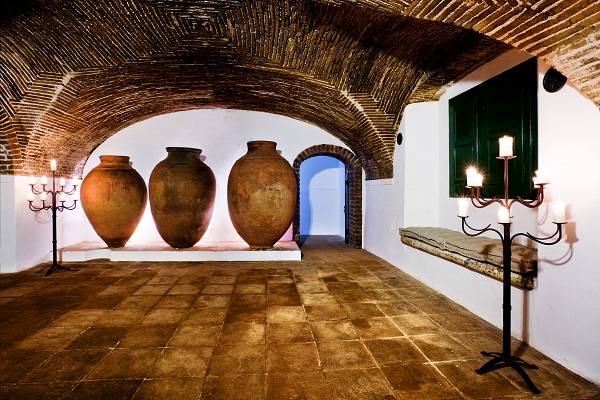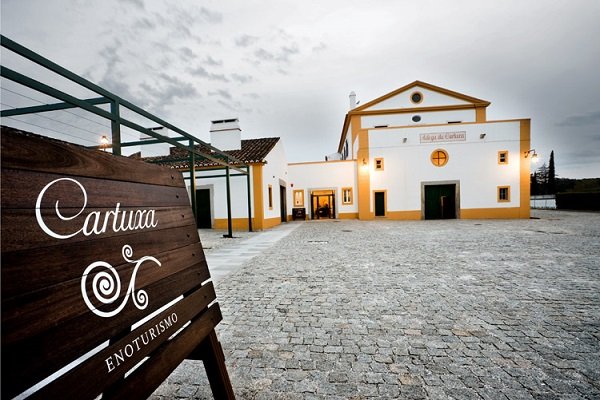Today, Évora is a charming city with a rich culture, cuisine and history. As a visitor in Évora, you'll find plenty of things to see and do in this historic city in Portugal: One can explore the well-preserved Roman Temple, admire the grandeur of the Évora Cathedral, take a stroll through the UNESCO World Heritage-listed historic center of Évora, step into the eerie yet fascinating Capela dos Ossos, a chapel adorned with the bones of over 5,000 individuals, and visit the Évora Museum to learn about the history and culture of the region.
But, many visitors are pleasantly surprised to find out it is and has almost always been a wine region. There are numerous wine shops and wine bars where you can taste and purchase wines from Alentejo, including those from Évora. Beyond that there is a Tasting Room in Évora run by the Wines of the Alentejo.
Inside the city limits, the Cartuxa Winery is an esteemed producer of Portuguese wines on more than 600 hectares of vineyards, offering a delightful experience for wine enthusiasts and visitors alike. And, unlike other producers Cartuxa is a nonprofit that puts its profits back into the community.
Wines that pre-date Portugal
Long before Portugal emerged as a nation in the 12th century, Évora’s unique soil and climate was giving up great wines. Built on a foundation for wine making from ancient times, celebrated by Romans - and thriving in the Middle Ages - Évora’s wines explored the world with the Portuguese. This is the story of the rise, fall and rise of the wine city of Évora.
For centuries Évora was a wine city -The history of the wines of Évora dates back centuries to ancient time. Évora was renowned for its winemaking traditions and fertile lands. Grapes may have come with the Greeks and Phoneicians. But it was the Romans, who came to the Iberian Peninsula in the 2nd century BCE, who recognized the favorable conditions for viticulture and introduced grape cultivation around Evora. They massively expanded the city around 30 BCE, growing wheat and grapes.
During the medieval period, the winemaking tradition thrived in Évora.
Local wines, made in the Roman way in clay amphoras, gained prominence due to their quality – becoming a valuable commodity for trade. By the Age of Exploration Évora saw a boom in vineyards and wine production.
With the Portuguese Seaborne Empire, the wines of Évora gained recognition internationally - accompanying Portuguese ships around the world.
But the city’s luck changed when in the late 19th century, the phylloxera epidemic devastated vineyards in Évora. Then in the 1930s, the government of the Estado Novo encouraged grapes to be pulled up to support their campaign to grow more wheat.
Only in the late 20th century did the wine industry revive with the introduction of modern winemaking technology, and a focus on quality.
In 1989, the Alentejo region, including Évora, was recognized as a Denomination of Origin (DOC) for its wines. The designation ensures that wines produced in the region meet specific quality standards and are representative of the terroir.
Thanks to the Cartuxa Winery, the wines of Évora soon gained increasing recognition and popularity. Évora is again known for its red wines, which are typically full-bodied, rich, and fruity.
Cartuxa’s wine makers embrace innovation with a nod to the past producing a diverse range of wines that showcase the unique characteristics of the Alentejo. Visitors to Évora can see the vineyards, historic winery, and wine cellars, and experience the rich winemaking heritage of this fabled winery.

About the wines…
The Alentejo is a wine region located in the southern part of Portugal, with Évora being one of the sub-regions. Today’s wines of Alentejo offer a delightful representation of local winemaking, reflecting the region's history, climate, and terroir. The wines of Alentejo, including those from Évora, are praised for their quality and unique characteristics. The region benefits from a dry Mediterranean climate with hot summers and mild winters, ideal for grape cultivation. The vineyards in Évora are typically situated on rolling hills with clay and limestone soils, providing prime conditions for growing grapes.
Red wines are historically prominent in Alentejo. The region is known for producing full-bodied, richly flavored red wines that often exhibit ripe fruit flavors, balanced acidity, and well-integrated tannins. Popular red grape varieties in Évora include Trincadeira, Aragonez (known as Tempranillo in Spain), Alicante Bouschet, and Touriga Nacional.
In addition to red wines, Évora also produces some innovative white and rosé wines. Whites from the region are typically crisp, refreshing, and aromatic, often made from grape varieties such as Antão Vaz, Arinto, and Roupeiro.
Évora and the Alentejo region as a whole have seen some significant advancements in winemaking techniques and quality in recent decades.
The wineries in and around Évora have embraced modern tech while still honoring traditional winemaking ideals, resulting in wines that showcase the unique terroir of the region.
The Alentejo region, including Évora, has several visitor centers where wine enthusiasts can learn about the wines, wineries, and vineyards of the area. These visitor centers provide a unique opportunity to explore and taste the wines of Alentejo, including those specifically from Évora. While I don't have access to real-time information, I can provide you with some general information about visitor centers in the region.
Wines of Alentejo Visitor Center
Anyone who enjoys a good wine and is in Évora needs to visit the "Rota de Vinhos do Alentejo" headquarters (Alentejo Wine Center). Located steps from the cathedral and the Roman temple of Évora, this center is dedicated to educating on and showcasing the wines of Alentejo. Wines of Alentejo Évora Regional Winegrowing Commission runs the nonprofit center. The CVRA is an organization that represents the many wine producers in the Alentejo region, and their visitor center in Évora provides information and promotes the wines of Alentejo. Visitors can learn about the different wine producers in the region, the unique characteristics of Alentejo wines, and the various wine routes and tasting experiences available. Here, visitors can learn about the region's winemaking past, vineyards, grape varieties, soils and winemaking techniques through interactive displays, exhibits, and informative presentations in various languages. The center offers wine tastings, allowing visitors to sample (and buy) a selection of wines from different producers.
Wine Shops and Estates
Another option is to visit individual wineries and vineyards around Évora that have their own visitor centers or tasting rooms. Many wineries in the region are open to the public and offer guided tours of their facilities, vineyards, and cellars. The Alentejo Wine Route offers access to more than 60 participating wineries distributed throughout the Alentejo.
These tours often include wine tastings, allowing visitors to experience the wines firsthand and learn about the specific winemaking processes employed by each producer. Some wineries require advance booking, and it's advisable to check their websites and contact them directly for more information.
One local shop that has a lot to offer is The Ervideira Wine Shop, run by one of the leading wineries in the region. Known for their innovative approach to winemaking, incorporating traditional methods with modern techniques. At the Ervideira Wine Shop, visitors can sample a range of wines. They offer tastings and can guide you through the different wines available, explaining their characteristics and the winemaking process. It's a great opportunity to learn about the Alentejo region's wine culture and discover unique and delicious wines.
Cartuxa is Evora Wine - build with a cause
The Cartuxa Winery is a storied winery set not far from the walls of Évora. It is known for producing high-quality wines, particularly from indigenous grape varieties grown in the region. The winery is associated with the Eugénio de Almeida Foundation, which has a long history of winemaking and promoting cultural and educational initiatives in the area.
The Cartuxa Winery is The winery is closely associated with the nearby Carthusian Monastery of Santa Maria Scala Coeli, which was founded in the 16th century. The Carthusian monks played a huge role in the establishment and development of winemaking in the region. They recognized the potential of the local climate and soil for viticulture, producing wine with a reputation for exceptional quality.
The convent passed into the hands of the state in the early 19th century, and was sold by the late 19th century. The winery underwent modernization and expansion in the mid 20th century under the guidance of Vasco Maria Eugénio de Almeida, a prominent businessman and philanthropist.
Under Eugénio de Almeida's leadership, Cartuxa Winery thrived and gained recognition as one of the leading wine producers in Portugal.
When Eugénio de Almeida died, he left the estate to a foundation, dedicated to the benefit of the local community.
Today, the Cartuxa Winery produces a range of wines, including red, white, and rosé wines. Some of its most notable wines include the Cartuxa Red, made from a blend of traditional Portuguese grape varieties, and Pêra-Manca, a premium wine highly regarded for its excellence.vIt is made from a blend of Trincadeira and Aragonez grapes and has received numerous accolades and awards. Cartuxa Winery also produces other premium wines under different labels, such as Cartuxa Colheita, Cartuxa Reserva, and EA, among others.
In addition to winemaking, the Cartuxa brand also encompasses other agricultural activities, such as olive oil production and cork harvesting. But its wines are enjoyed both domestically and internationally, and the winery stands as a symbol of Evora’s winemaking heritage and craftsmanship.
The Cartuxa winery's vineyards benefit from the region's Mediterranean climate, with hot summers and mild winters, which are ideal for grape cultivation.
Visitors to the Cartuxa Winery can take guided tours of the vineyards and the winemaking facilities, gaining insights into the winemaking process and the history of the winery. Tastings of their wines are also available, allowing visitors to sample and appreciate the distinct flavors and characteristics of the Cartuxa wines.



